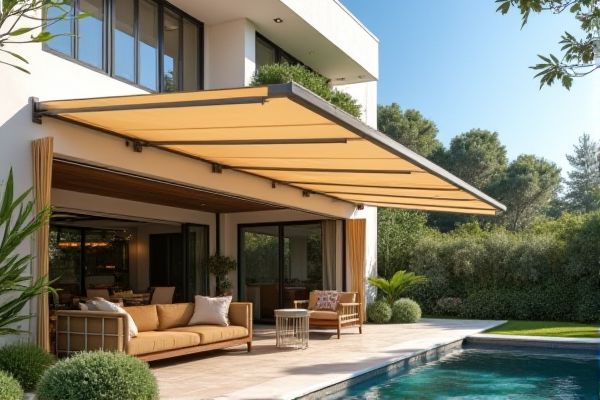
Manual awnings offer simplicity and cost-effectiveness with easy control through a hand crank, ideal for areas requiring minimal adjustments. Motorized awnings provide convenience and enhanced functionality with remote operation, perfect for maximizing comfort and efficiency in your outdoor space. Discover the full comparison to decide which awning suits your needs best.
Table of Comparison
| Feature | Manual Awning | Motorized Awning |
|---|---|---|
| Operation | Hand-crank or pull | Remote control or switch |
| Installation Cost | Lower | Higher (due to motor and wiring) |
| Convenience | Requires physical effort | Easily operated with no effort |
| Durability | Less mechanical parts, fewer failures | Motor components may need maintenance |
| Automation Features | None | Can include sensors for wind, sun, rain |
| Control Options | Manual only | Remote, smartphone, smart home integration |
| Energy Requirement | None | Electricity required |
| Price Range | $100 - $500 | $500 - $2,500+ |
Introduction to Manual and Motorized Awnings
Manual awnings operate through a simple hand-crank mechanism, offering cost-effective and easy-to-maintain shading solutions ideal for smaller spaces or infrequent use. Motorized awnings feature electric motors controlled by remote or smart systems, providing enhanced convenience and precision in adjusting shade levels for larger patios and commercial properties. Both types improve outdoor comfort and protect furniture from UV damage, but motorized versions deliver superior automation and integration with home automation systems.
Core Differences Between Manual and Motorized Awnings
Manual awnings require physical effort to extend and retract, typically using a hand crank, while motorized awnings operate with an electric motor controlled by a remote or wall switch. Motorized models offer enhanced convenience, faster operation, and the ability to integrate with smart home systems, unlike manual versions. Cost and installation complexity differ significantly, with motorized awnings generally being more expensive and requiring professional installation compared to the simpler setup of manual awnings.
Installation Process: Manual vs Motorized Awnings
Manual awnings feature a straightforward installation process that typically requires basic tools and can be completed quickly by homeowners or professionals. Motorized awnings involve a more complex installation, requiring electrical wiring and sometimes integration with smart home systems, thus often needing professional assistance. The added complexity of motorized awning installation ensures enhanced functionality, such as remote control operation and automated sun tracking.
Cost Comparison: Manual vs Motorized Awnings
Manual awnings typically have a lower upfront cost, ranging from $200 to $800, making them a budget-friendly option for homeowners. Motorized awnings, priced between $1,000 and $3,000, offer convenience and ease of use but require additional expenses for installation and electrical components. Your decision should balance initial investment against long-term benefits like automation and durability.
Ease of Use and Accessibility
Motorized awnings offer superior ease of use and accessibility by allowing users to extend or retract the awning with the push of a button, ideal for individuals with mobility challenges. Manual awnings require physical effort, using a crank handle to operate, which can be cumbersome for those with limited strength or dexterity. Automated models often include remote controls or smart home integration, further enhancing convenience and accessibility.
Durability and Maintenance Requirements
Manual awnings typically feature simpler mechanical components, resulting in higher durability and lower maintenance requirements compared to motorized awnings. Motorized awnings incorporate electrical parts and motors that may need regular servicing or repairs due to wear or exposure to weather elements. Your choice between the two should consider the long-term maintenance commitment and the environment where the awning will be installed.
Energy Efficiency and Sun Protection
Manual awnings provide effective sun protection by shading windows and outdoor spaces, reducing heat gain and lowering cooling costs without using electricity, making them an energy-efficient choice. Motorized awnings enhance convenience by allowing you to adjust shading automatically based on sunlight intensity, optimizing energy savings by preventing overheating inside your home. Both options improve comfort, but motorized systems offer precise control for maximizing sun protection and energy efficiency.
Customization and Design Options
Manual awnings offer a wide range of customization options, including fabric choices, colors, patterns, and frame styles that can be tailored to enhance any architectural aesthetic. Motorized awnings provide advanced design features such as automated retractable extensions, remote control operation, and integration with smart home systems, allowing for seamless convenience and precise positioning. Both options support diverse customization, but motorized awnings elevate functionality with technology-driven design adaptations.
Safety and Weather Adaptability Features
Manual awnings offer straightforward, reliable operation with fewer mechanical parts, reducing the risk of malfunction and enhancing safety during power outages or storms. Motorized awnings feature advanced weather adaptability through integrated sensors that automatically retract the awning in high winds or heavy rain, protecting your property and ensuring durability. Choosing a motorized awning provides enhanced safety and convenience, while manual options remain dependable in unpredictable weather without reliance on electricity.
Choosing the Right Awning for Your Needs
Manual awnings offer cost-effective, reliable shade control with simple operation, making them ideal for smaller spaces or infrequent use. Motorized awnings provide convenience and enhanced functionality through remote controls and automated sensors, perfect for larger areas or frequent adjustments. Assessing factors like budget, ease of use, maintenance, and desired automation helps determine the best awning solution tailored to your lifestyle and outdoor space.
 homyna.com
homyna.com